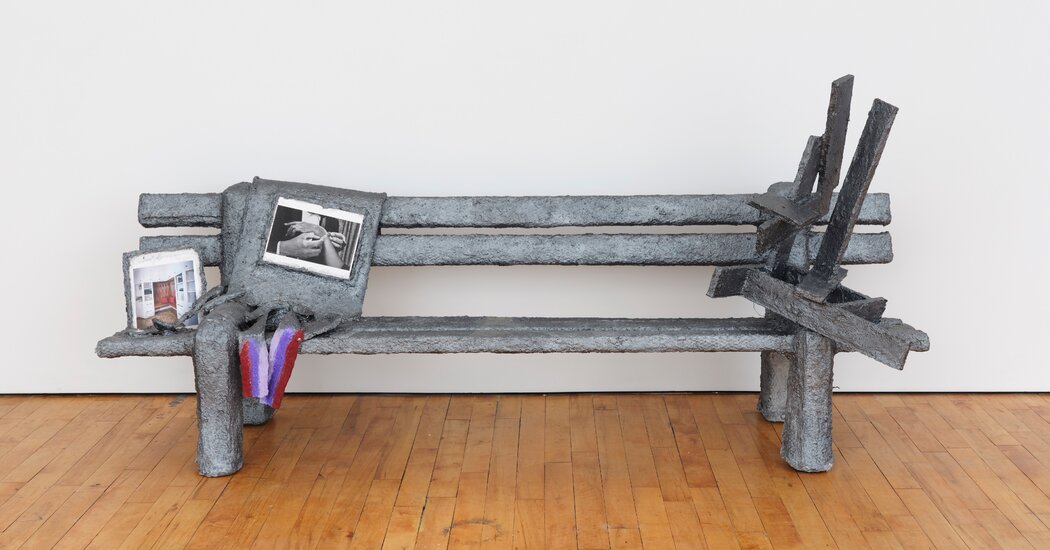This week in Newly Reviewed, Travis Diehl covers Kianja Strobert’s silver benches, Anna-Bella Papp’s elegant clay slabs and Amanda Rodriguez’s playful watercolors.
Noho
Kianja Strobert
Through April 5. Marinaro, 678 Broadway; 212-989-7700, marinaro.biz.
The gallery has the aura of a city park, equal parts hospitable and estranging. That feeling comes from Kianja Strobert’s bench sculptures, arranged in rows and alcoves, inferring a social structure you intuitively understand and want to respect. The benches, wood and papier-mâché at their core, are forbiddingly painted with leaden silver gloop but invitingly unpristine.
Piles of refuse litter the seats, as do blankets, fresh clothes and trinkets like pearls and barbells and a votive candle. Colorful pages from home décor magazines and a retro-looking 2024 calendar of flowers pop against the uniform gray. A paper shopping bag labeled Medium Brown Bag, like those from Bloomingdale’s, is encased in clear vinyl and sits on the end of one bench like someone just forgot it.
And, as with many ostensibly public urban spaces, there’s tension: One bench, “Untitled #10,” is laced with saw-toothed strips resembling the kind of hostile architectural interventions meant to keep the huddled masses moving. Next to them is an elongated photo of a woman’s legs. The benches are deployed with qualified generosity, like casting pearls before swine — a contradiction compounded in the gallery by the fact that you can’t sit on them.
The triple lines of draped pewter-hued flags in “Bunting,” a papier-mâché wall work set above — what else — a bench, offer another counterpoint, a surge of celebration. It’s like the city, after all: a harsh buffet. The benches benefit from their arrangement, the cross-references of the possible plots. As a whole lot, the scene is twee apocalypse; it’s hard to imagine a single sculpture having the same resonance.
Lower East Side
Anna-Bella Papp
Through April 13. Dracula’s Revenge, 105 Henry Street; 203-517-8385, draculasrevenge.net.
In this elegant show by the Romanian artist Anna-Bella Papp, four clay slabs, each about 13 inches by 10 inches and one inch thick, are arranged on blond wood Ikea shelves. They’re as precisely, inseparably installed as four frames of a film. Each bears a high-contrast image of a wrought-iron fence. From left to right, the view starts with a flower, then gradually pulls back to show more of the ironwork.
As information emerges, so does distance. If you were to imagine a narrative, it could be as simple as: The metal bloom catches the artist’s eye, then the artist notices that the whole fence is made of these springy curlicues — a revelation that’s joyful, since the more the merrier, but also cut with loss, since that first flower is not so special after all.
Papp works almost exclusively in clay slabs like these, always laid flat. For this group, the images are pressed into a thin layer of powder blue clay on top of a gray base, then the relief is filled smooth with milky white. The white on powder blue recalls a classic Wedgewood china pattern. Here the effect is wispy and waxy, and the sculptures feel almost animated.
The show hinges on the tension produced by small decisions, like the slabs’ tantalizing closeness to the wall: Shouldn’t they be on it? But the slabs, for all their earthy weightiness, feel fragile, bound by impossibly sharp edges. You may also notice the color variation, a clue that the two outer panels are baked ceramic, while the middle two are unfired. The idea of moving them seems treacherous. Papp’s show is cryptic and evasive in a way that doesn’t need solving.
Lower East Side
Amanda Rodriguez
Through April 26. Entrance Gallery, 48 Ludlow Street; 646-838-5188, entrance.nyc.
Playful new watercolors by Amanda Rodriguez in her debut solo show depict unlikely transmogrifications between animals, humans and inanimate objects that loop back on each other, forming a macabre cosmic wheel.
In the upstairs gallery, 16 square paintings run around the walls on a shelf. Between every pair of legible illustrations is a strange blend of the two. A stunned deer in headlights morphs into a lobster over the course of three panels; the deer’s star-struck blue eyes become the rubber bands binding the lobster’s claws. Two panels later, we have a lobster dinner. Phase through a woman at her toilette, a worm on a hook, a fish, a host of Gothic angels. And, finally, a red car striking a deer — which brings us full circle.
Downstairs, arched paintings work a quasi-Christian sense of narrative stained-glass windows or altarpieces into the layouts of pinball machines. In one, a central figure lugs sacks of cans and bottles rendered as colorful daubs; yellow pinball bumpers are decorated with a handgun or subway car doors closing. It’s a fairly romanticized picture of life in New York City, percussive shots and cries depicted as gossamer clichés.
Another watercolor echoes the transformations upstairs in a central rosette, showing a baby growing up, transforming into a fish-person, getting married and having a human baby of their own. While the details feel churning and random, the larger picture has a satisfying cyclical shape.
See the March gallery shows here.
